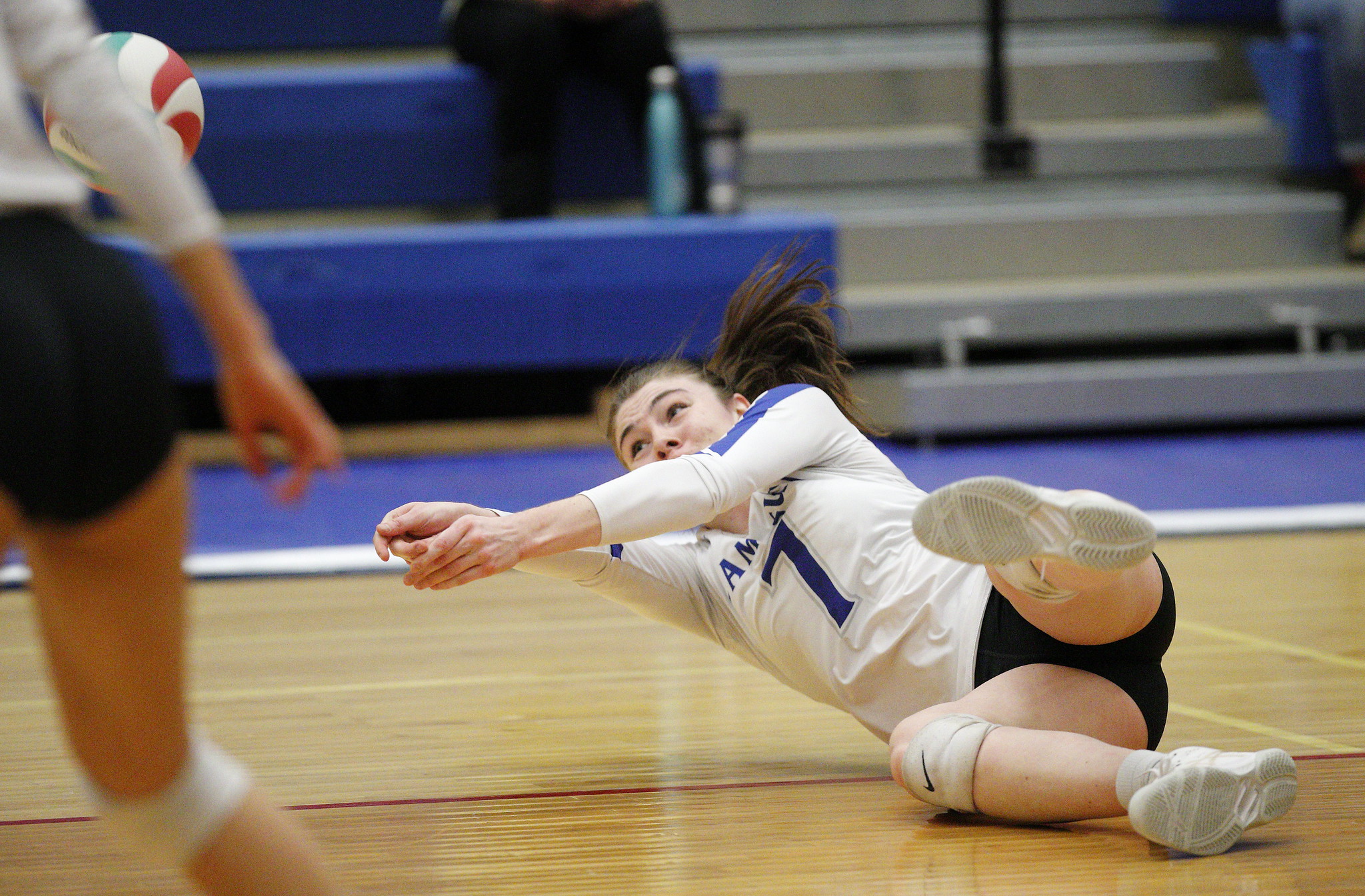

This training program is all about covering more court quickly so you can make miraculous digs. You will do drills that help you develop flexibility and explosiveness. Follow along and put in the work to become the best defender in the gym.
This program can be done anywhere you have a few meters to shuffle around in, but if you have access to some hardwood and a teammate then it's even better.
It is recommended to also do some general strength training for your lower body to help get the most out of this type of training. Starting into the Crazy Vert Series would also be a good use of your time, if increasing speed and power are a high priority for you.



This is a general warm up for your whole body. Follow along with this video to master the whole sequence. It will take a few tries to get it right but once you've got it committed to memory it goes quite quickly.
This portion of your warm up should leave you feeling loosened up so you can move on to higher intensity movements that may be a part of your specific warm up. One round may be enough, depending on your fitness level. If not, repeat as needed.



Starting in a pushup position, bring one foot up beside your hands, outside your body. Sink your hips so that you feel a stretch in the front of the straight leg and/or the back of your bent leg. Twist to reach each hand up toward the ceiling. Then rock back onto your heel and straighten your front leg to feel a stretch in the back of your thigh or knee. Return to the starting position and repeat on the other side.
Perform a minimum of 5 on each side before moving on, 8 is ideal.



In a pushup position, bring one knee up and put it down between your hands with your foot out to the side. Sink your body weight onto that leg so that you feel a stretch in your glutes. Hold for 1-2 seconds and return to the pushup position.
Perform 8-10 on each side.



With your feet in a comfortable position around shoulder width, lower yourself down as far down as you are able into a squatting position.
Your weight should remain balanced through your foot - a common mistake is to lift your heels and/or put all of your weight into your forefoot.
Make an effort to remain somewhat upright, allowing your hips and knees to bend deeply - a common mistake is to lean forward with a rounded back.
Perform 8-15 repetitions before moving on, if this is part of your warm up.
Perform 2-3 sets of 10-15 repetitions, resting 90 seconds in between sets, if this is part of your workout.



Keeping your arms out to either side and your feet stationary, twist into a lunge position in either direction. This movement can be done quickly. Search for a stretching sensation in the front of your thigh on your back leg by ensuring you rotate well to either side and remain tall through your back.
Do 5-8 on each side.



Tip your whole body forward while standing on one leg - keep only a slight bend in your knee. Keep your body in a straight line from your head down to your foot while going down until you feel a stretch in the back of your leg. Make an effot to keep your shoulders and hips from rotating to the side.
Perform 5-8 on each side.



Lie on your stomach, with one leg bent out to the side. Place the roller across the inner thigh muscles, under your bent leg. Roll sideways so the roller works along the length of the muscles.
Roll for 1 minute on each side.
At first, this exercise may be painful; a softer roller will be easier to tolerate early on. You also put more or less of your weight onto the floor, to modulate the pressure your put into your thigh and the roller.
Progress by finding a firmer roller or one with a textured, knobby surface.



Sit with the roller across the backs of your thighs. Roll along the length of your thigh(s) from just above the back of your knee up to your butt.
Roll for 1 minute on each side.
At first, this exercise may be painful; a softer roller will be easier to tolerate early on. You also want to roll both legs at once, to reduce the pressure your put onto each leg. Progress by finding a firmer roller or one with a textured, knobby surface.



Sit with your knees bent and feet flat on the floor in front of you, shoulder width apart. Lower your knees to one side until both of them are on the floor. You'll have to turn to face sideways to let this movement happen. Keeping your knees and lower legs in contact with the floor, lift our hips up and rise up as high as you can. Return to the starting position and repeat on the other side.
Do 8 on each side.



Stand facing a wall in your defensive ready position. Throw a reaction ball against the wall (or a regular tennis ball against a wall with a varied surface - such as a stone retaining wall). React to the direction of the ball and try to catch it after the first bounce off the ground.
Another way to do this drill is with a friend throwing a lacrosse ball against the wall from behind you. A little spin on the ball makes it tougher to anticipate.
Do this drill for 3 rounds of 30 seconds, resting for 2 minutes in between efforts.
*While this is an excellent drill for working on your quickness, it's not a substitute for on court defensive training. Trying to use the same shuffling and diving movements you've been taught for defense will help these skills transfer.



These exercises can be done either on or off the volleyball court, and are designed to help you develop quickness with your volleyball-specific defensive movements.
Begin in your defensive ready position. If you have the chance to train on a volleyball court, set up in your base position in the position you usually play. Depending on your position you may choose to alternate directions or do all of your repetitions the same way.
Version 1: Shuffle as fast as possible to the side and quickly stop in a balanced, defensive position. Reset and repeat.
- This mimics a simple defensive response to the setter's selection
Version 2: Shuffle as fast as possible to the side, then quickly shuffle back to your base position and stop in a defensive stance. Reset and repeat.
- This mimics responding to the set direction, but then needing to make a quick adjustment.
- See the video here: https://youtu.be/-3EAfVAQAGc
Version 3 & 4: Do version 1 or version 2, but with a partner hitting at you on a box
- See the video here: https://youtu.be/PQlXgf7Ndr4
Do 3 sets of 10 repetitions, resting for 2 minutes in between sets, if you've chosen version 1 or 3.
Do 3 sets of 6 repetitions, resting for 2 minutes in between sets, if you've chosen version 2 or 4.
***If you want to work more on endurance, rather than quickness, do as many as you can in 30 seconds, resting for 60 seconds between sets.
It's a good idea to practice multiple versions to help develop all around quickness, but keep in mind that digging a volleyball will help make this training transfer to your on court skills more easily. It's recommended to choose Versions 3 and 4 whenever you get the chance.
Regardless of what version you choose, make movement speed and the amount of court you cover your top priorities. Get help from a coach if you're not sure what kind of footwork is ideal.



These exercises can be done either on or off the volleyball court, and are designed to help you develop quickness with your volleyball-specific defensive movements.
Begin in your defensive ready position in position 1 or 5. Split step and drop back two steps, as if to defend a line attack. Then run forward and dive, as if to dig a tip.
This can also be done with a partner hitting off a box, to make it more game-like: https://youtu.be/VanBY4FzdfI
Do 3 sets of 8 repetitions, resting for 2 minutes in between sets.
Either of these drills will help you develop quickness, but keep in mind that digging a volleyball will help make this training transfer to your on court skills more easily. It's recommended to train against an attacker whenever you get the chance.
Regardless of what version you choose, make movement speed and the amount of court you cover your top priorities. Get help from a coach if you're not sure what kind of footwork is ideal.



Face sideways to a wall (a partner or open space also work). Lower into a ready position. Using your lower body to produce power, push off explosively and throw the ball with two hands toward the wall. Repeat facing the other direction. Select a medicine ball that is heavy enough to slow you down a bit - somewhere between 10 and 30 lbs (5-15 kg) is probably good, depending on how strong you are.
Start far enough away from the wall so you don't have to hold back because you have to prepare quickly for the ball to bounce back.
Perform 5-8 per side, 2-3 times, resting about 2 minutes between sets.



Holding a kettlebell overhead and standing with your feet shoulder width apart, turn both feet to face diagonally to the same side. Keeping both legs fairly straight, shift your hips backward as you bend forward, lowering your free hand toward the floor between your feet. Go down to the limit of your flexibility before returning to an upright position. Some people find it helpful to look up at the kettlebell throughout the movement to help keep their back straight.
Do 3 sets of 8 repetitions on each side, resting for 90 seconds between sets.
This exercise is intended to help you build strength and flexibility, and it can also be done with a dumbell (or something else heavy) instead of a kettlebell.
Use about 10-15 lbs (5-7 kg) if you've never done this before, and progress by increasing your range of motion and holding more weight. For experienced lifters, 20-25 lbs (8-10 kg) is a good starting point.
***If this is too challenging for you, try holding the kettlebell in your bottom hand, with your other side simply reaching upward with an empty hand.